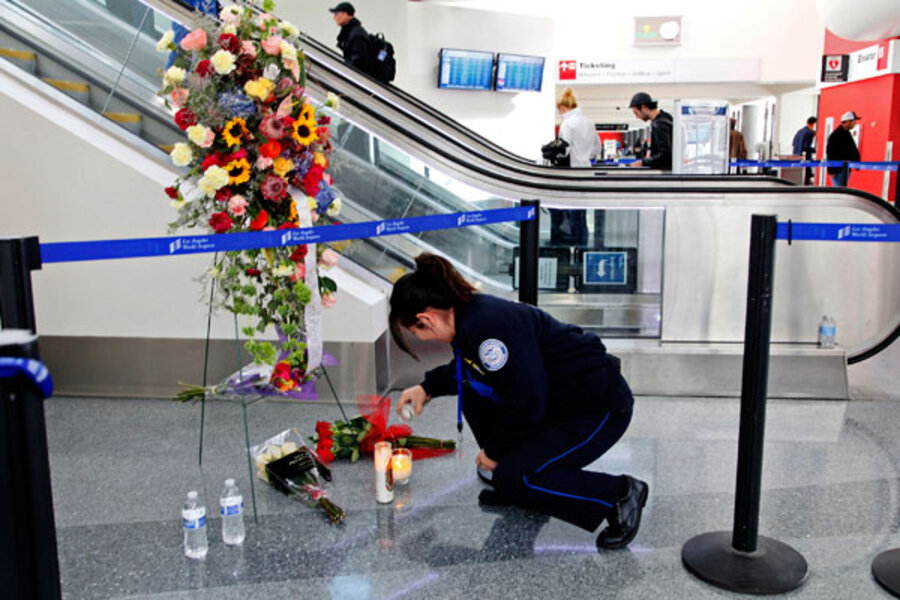LAX shooting: Should TSA officers be armed?
Loading...
| Los Angeles
The head of the union that represents Transportation Security Agency employees said Monday that the time has come to consider arming some of agency's 45,000 officers.
The call by J. David Cox Sr., president of the American Federation of Government Employees, comes after Friday's shooting rampage at Los Angeles International Airport, in which witnesses say the shooter specifically sought out TSA agents, killing one.
But public-security experts are wary of putting guns into the hands of TSA officers. Moreover, they suggest that it is impossible to make every location safe from someone with a gun. With a heavy security presence already seeping into more of American public life, they wonder where a line will be drawn.
“We know we can provide extraordinary security measures wherever and whenever we want, but the question needs to be asked by society as a whole: Are we going to protect every airport, supermarket, mall, and school – and at what cost and inconvenience?” asks Brian Jenkins, an expert on terrorism and aviation at Rand Corp., a think tank in Santa Monica, Calif.
Attorney General Eric Holder, who is overseeing an investigation of the incident, said on Monday that "the responsibility for protecting airport security is not a TSA function, but something I think we need to certainly examine."
Union leader Mr. Cox is not suggesting arming all TSA officers but rather "the development of a new class of TSA officers with law enforcement status," he said in a statement.
In general, however, the idea of arming TSA officers is getting pushback.
“The requirements of training and educating thousands of these agents would have to be extensive, and that is not the function of a TSA screener,” says Scott White, a criminologist with the Goodwin College of Professional Studies at Drexel University in Philadelphia.
To some, arming TSA officers would represent a ramping up of the security wars at US airports.
“TSA should not be armed for the same reason that most security guards should not be armed,” adds Steve Lee, a security consultant in Los Angeles. “They work in people-congested areas without appropriate law-enforcement or firearms training. The risks associated with arming them far exceed the risks attendant upon not arming them. “
In the end, arming TSA officers would merely become a security shell game, says Mr. White.
“In a free, democratic society, it’s almost impossible to make every potential target impenetrable by some possible shooter,” he says. “If you move the protected perimeter, they just adjust accordingly, and if you shut down whatever entity it is – school, mall, market – they just move on to the next target.”
There is also the question of whether the public – which has never fully warmed to the existence of the TSA – would look favorably on armed TSA personnel, he and other say. Reports suggest that the alleged shooter, Paul Ciancia, had antigovernment motives and saw TSA officers as usurpers of American liberties.
Better ways to improve security would include improving technology and simplifying emergency plans, some say.
“I can’t tell you how many municipal security entities have five or six different kinds of camera technologies that can’t really respond ... in ways that help during an emergency,” says Dwayne Healy, who was hired by the city of Los Angeles after 9/11 to coordinate the region’s patchwork of technology-based response plans.
“Then they have these response-plan manuals that are four to five inches thick and way too complicated,” says Mr. Healy, who is director of business development, retail, and hospitality at Avigilon, which sells HD surveillance cameras.
LAX has spent a reported $1.6 billion in new security measures since 9/11, adding checkpoints for cars, bollards and other road- and structure-access devices, a quick reaction force (QRF), video and motion surveillance, facial recognition software, and more-sophisticated communication equipment for first responders. Officials have increased their ability to control traffic, overall and terminal by terminal.
Law-enforcement officials at LAX have been hailed as heroes for responding so quickly; Mr. Ciancia was shot four times and taken into custody, where he remains heavily sedated.
But what is most needed are programs to deal broadly with emotional literacy and the causes and treatment of mental illness, says Wendy Patrick, author of “Reading People: How to Understand People and Predict Their Behavior, Anytime and Anyplace.”
“As a country, we need to eliminate this strange stigma around the necessity of asking for or giving help to those who are disturbed.”







